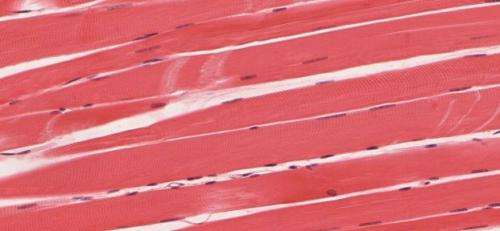
Muscles appear to grow, rather than shrink, in some critically ill COVID-19 patients, finds new research being presented at Euroanaesthesia, the annual meeting of the European Society of Anaesthesiology and Intensive Care (ESAIC), held online this year.
Bed rest and mechanical ventilation can lead to muscle wastage, which can hamper recovery and affect mobility and quality of life. Previous research has shown that muscle fibers atrophy by almost 20 percent after a week in ICU. There are concerns, however, that COVID may lead to even greater muscle damage.
To find out more, Dr. Toon Mostien and colleagues at the Jessa Hospital, Hasselt, and Hasselt University, Belgium took muscle biopsies from critically ill COVID patients before and after intensive care admission.
Eighteen patients had their vastus lateralis, the largest and most powerful muscle in the thigh, biopsied multiple times from one to three days before ICU admission to five to eight days after admission.
The patients had an average age of 69 years and 82 percent were male.
The samples were examined under the microscope for any changes that had occurred during the first week in ICU.
Type I muscle fibers (which support endurance activities) grew by 5.74 percent and type 2 fibers (which support quick, powerful moments) shrank by 5.17 percent but the changes weren’t statistically significant.
To the researchers’ surprise, the muscle fibers of four patients, however, increased “massively” in size. Type I fibers had swollen by 62 percent and type II fibers by 32 percent.
However, if these patients were excluded from the calculations, the remaining patients showed significant muscle wastage, says Dr. Mostien. Type I fibers shrank by 11 percent and type 2 fibers by 17 percent.
It isn’t known why the muscle fibers increased in size in four of the patients but one possibility is that their immune response to COVID damaged their mitochondria, the tiny structures that provide cells with energy.
This drop in energy could lead to more water accumulating inside the muscle cells, causing them to swell.
This type of swelling can lead to muscle fibers dying and so it is likely the increase in muscle fiber size was only temporary, says Dr. Mostien.
The researchers also examined of the number of capillary contacts—the number of capillaries perfusing the muscle fibers with the oxygen and nutrients they need to thrive.
This decreased by 5.37 percent and 9.68 percent for type I and type II muscle fibers, respectively. Dr. Mostien says: “Although the results were not significant, a drop in perfusion of almost 10 percent could potentially contribute to muscle fiber destruction.”
Dr. Mostien concludes: “There are concerns that immune response to COVID can exacerbate muscle wastage, meaning that critically ill COVID patients experience more severe muscle damage than the general ICU population.
Source: Read Full Article





